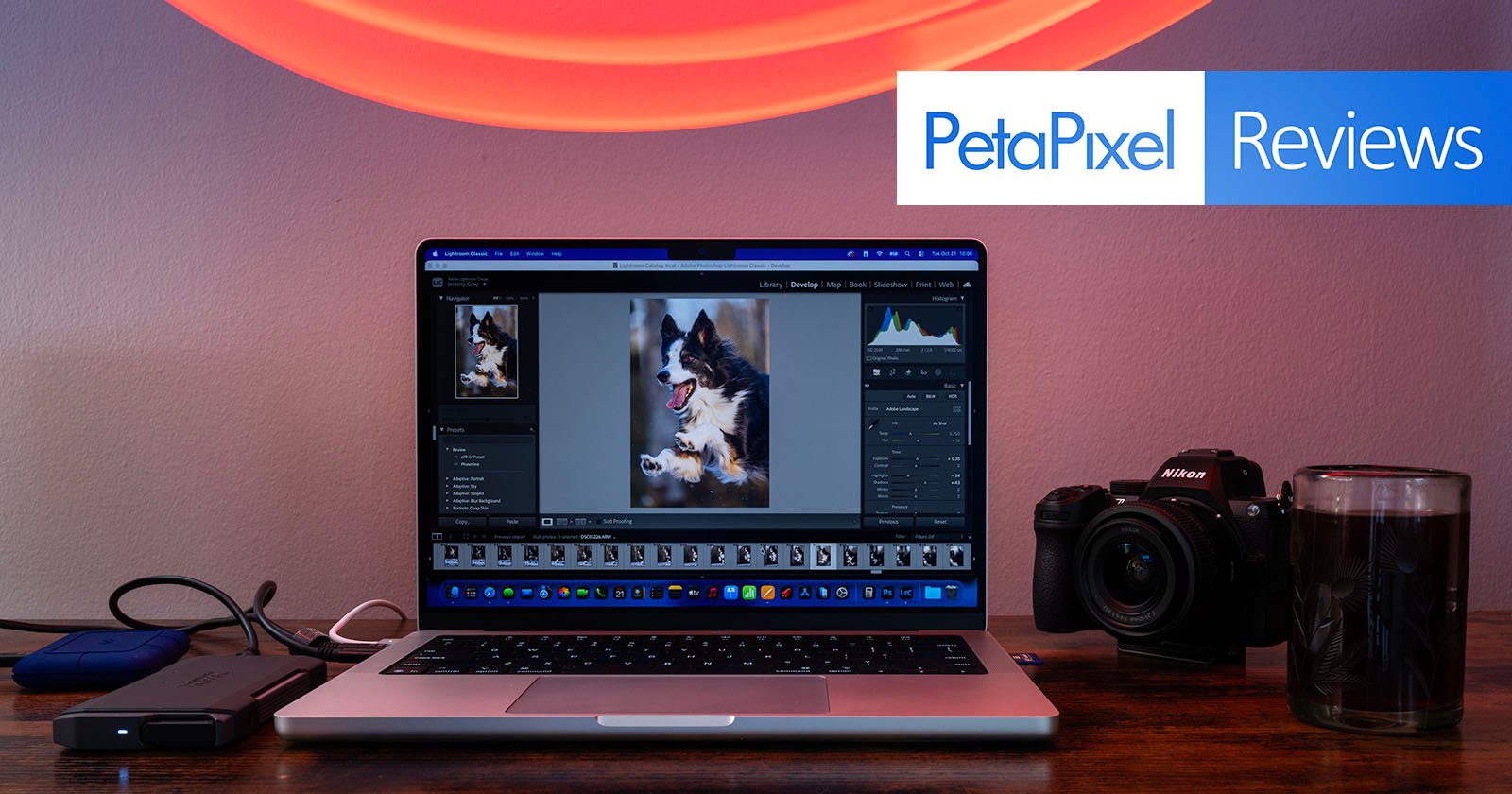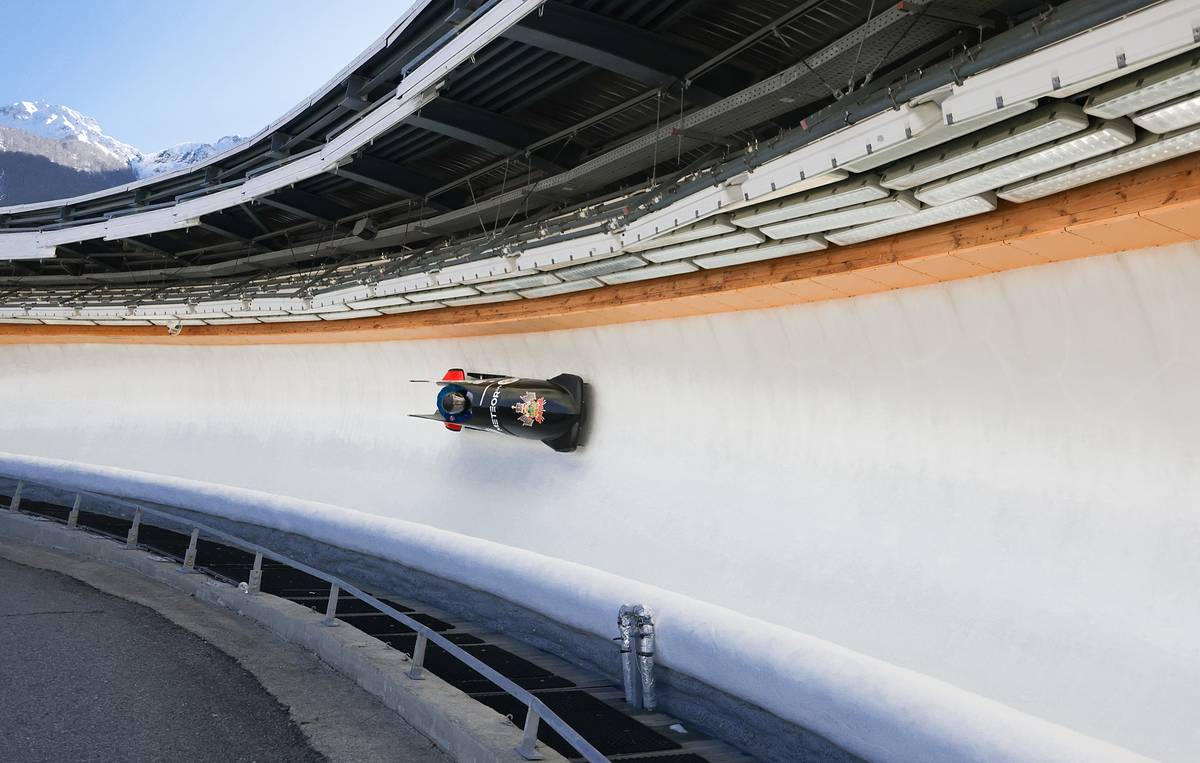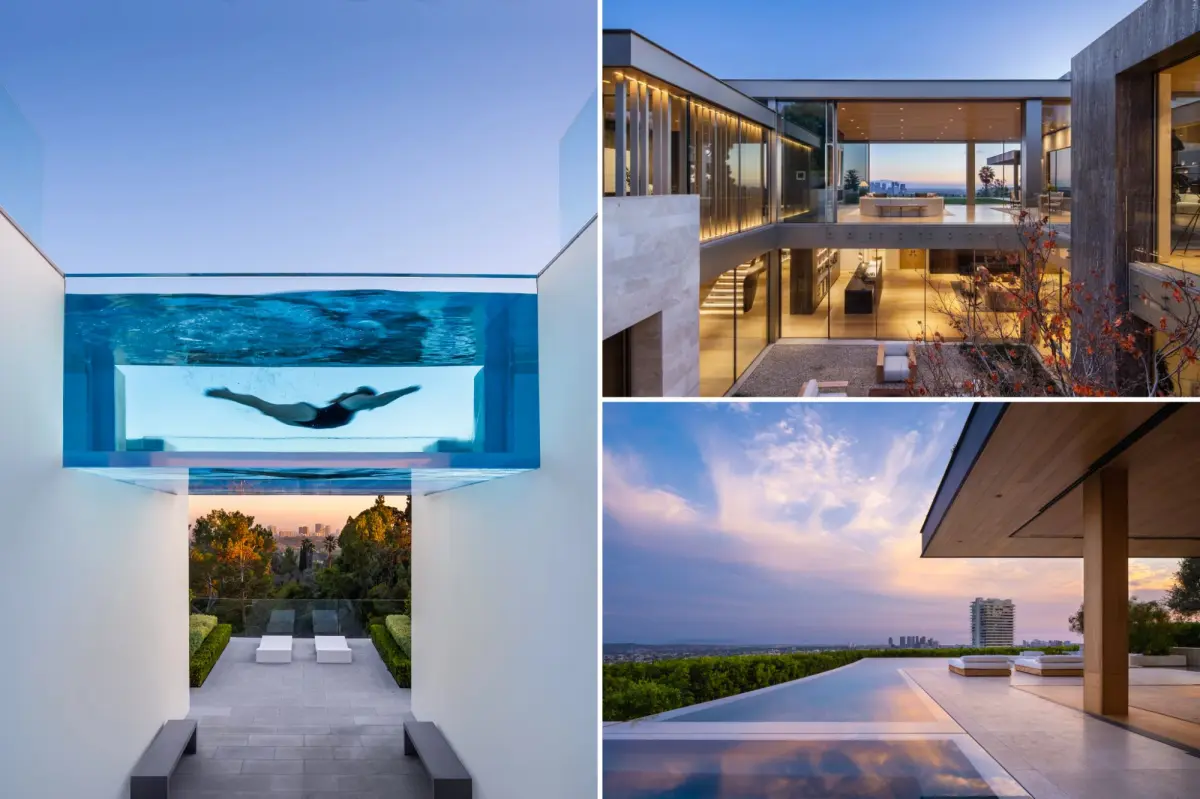Copyright PetaPixel

Although Apple’s Pro, Max, and Ultra-series chips rightly get significant attention in the creative professional space, the company’s base M-series chips are nothing to scoff at. The brand-new MacBook Pro with M5 (14-inch) is an excellent example of just how great Apple’s base model chips are. Photographers and most video editors should take notice, because the new MacBook Pro with M5 is a fantastic machine. As of now, Apple’s brand-new M5 is only featured in three products: the 14-inch MacBook Pro I’m reviewing here, the upgraded iPad Pro, and Apple’s improved Vision Pro headset. There’s little doubt the M5 will make its way to other computers in Apple’s lineup in due time. Further, how Apple Silicon works means that what we see here in the MacBook Pro will be very indicative of what we should expect from future M5-powered machines like a MacBook Air, Mac mini, and iMac, whenever those arrive. While an expected M5 MacBook Air probably won’t have a fan, the absence of one won’t impact most real-world performance situations. When testing Macs, we primarily evaluate what’s inside the machine: the M-series chip and the memory. In the case of this machine, the MacBook Pro I have on loan is the MacBook Pro with M5 (14-inch) with 10 CPU and 10 GPU cores, which is the only M5 configuration for the MacBook Pro (the iPad Pro with M5 can be had with one fewer GPU core). This configuration has 32GB of unified memory, although it is also available with 16GB or 24GB. I have 1TB of SSD storage in this machine, and configurations range from 512GB for the most affordable $1,599 model to 4TB. Finally, the MacBook Pro I have includes the optional nano-texture display, which I will discuss more later. All said, the configuration prices out to $2,349, although identical performance is available for $2,199 by removing the nano-texture display. As we will soon see, you get a ridiculous amount of performance for the price. Apple MacBook Pro with M5 (14-inch): Design and Build There’s nothing new here to note in terms of aesthetics or design since Apple redesigned its 14-inch and 16-inch MacBook Pro notebooks back in October 2021 with the M1 Pro and M1 Max-powered machines. While that might seem like a long time, and I suppose it is in terms of electronics, there isn’t really much to complain about when it comes to the newest MacBook Pro. It doesn’t look or feel outdated. Like last year’s MacBook Pro lineup, the upgraded M5 version ships in Space Black and Silver color ways. Apple sent me a Silver one, but those interested in seeing what the Space Black one would look like in real life can check out our Apple MacBook Pro with M4 Max Review from last year, as the Space Black on this machine hasn’t changed. Ports and Connectivity There’s nothing new to note here, either, and this is one area where I might knock the latest MacBook Pro, albeit only slightly. The laptop features three Thunderbolt 4 ports, two on the left and one on the right. These are joined by a MagSafe 3 port for power, although you can also use one of the Thunderbolt 4 ports, a headphone jack (left), an HDMI 2.1 port (right), and an SDXC card slot (right). The base M4 chip also only supports Thunderbolt 4, so it is not too surprising to see that carried forward to M5. However, given that the rest of the MacBook Pro with M5 is so darn powerful — as we will see shortly — I was admittedly a little disappointed to learn that none of the ports are Thunderbolt 5. While Thunderbolt 5 is still not widely adopted and there aren’t many devices that utilize it, those that do are very impressive. The new MacBook Pro’s SSD storage is twice as fast as before, which is excellent. However, I think creative pros would appreciate the ability to use Thunderbolt 5-equipped external storage on the new machine. Concerning the MacBook Pro with M5’s improved SSD speed. The 1TB drive in my test machine achieved 6,431 MB/s write speeds and 6,520 MB/s read speeds using Blackmagic’s Disk Speed Test app. For reference, a MacBook Air with M4 with a 2TB SSD offers about 3,074 and 2,800 MB/s, respectively, which is less than half the speeds of the new MacBook Pro with M5 for both write and read speeds. The lack of Thunderbolt 5 aside, the MacBook Pro with M5 still offers solid external display support and can handle two displays while maintaining full native resolution on its built-in display. For those who require 8K/60Hz or 4K/240Hz displays, the MacBook Pro can support one of these via HDMI. While chips like the M4 Max and M3 Ultra can support more displays than that, the MacBook Pro with M5 should prove sufficient for most use cases, especially for photographers. By the way, the MacBook Pro’s HDMI port also supports variable refresh rate (VRR), which is a nice feature. On the wireless connectivity side, the MacBook Pro features Wi-Fi 6E and Bluetooth 5.3. Wi-Fi 6E supports 6GHz network bands and can handle speeds up to 2.4Gbps, which is way beyond what my network offers. However, I’ll note that the Wi-Fi performed as expected, just like any of the other Macs I’ve used in recent years. Battery Life Battery life is a significant relative advantage of Apple’s Silicon across the board, and the M5 is no exception. The 14-inch MacBook Pro with M5 promises up to 24 hours of battery life when doing light tasks, like watching video. Web browsing is rated for 16 hours, per Apple’s metrics. This is the longest battery life ever on a Mac. In my experience, which has mostly been photo editing, web browsing, and running benchmarks, the MacBook Pro’s battery has proven to be quite good. I comfortably did a day’s worth of work, which includes working online, editing photos in Photoshop, and writing in Pages. The machine had plenty of life left to give. I don’t think I’d ever get 24 or even 16 hours of battery life using the laptop how I do, but I could definitely use it for 10 or 12 hours without issue. If it were a heavy photo editing day with a lot of Lightroom importing and editing, I’d expect the situation to change. Nonetheless, Apple’s strong battery life reputation remains intact here. By default, the notebook ships with a 70W charger, but there’s an optional 96W charger that can charge the MacBook Pro from zero percent to 50 percent in 30 minutes. Display and Sound The display has not changed this year, meaning that the 14.2-inch Liquid Retina XDR display remains fantastic. The ProMotion-equipped panel supports 1 billion colors, has full-screen HDR brightness of 1,000 nits, and peak HDR brightness on select portions of the screen tops out at 1,600 nits. While understandably, a lot of attention goes toward the screen’s maximum brightness, that’s not how I typically use a notebook. Unless I’m editing or watching HDR content, I’m not using the panel at full blast. Sometimes I work in the dark, especially on long flights or late at night. I know it’s bad for my eyes, but I appreciate that I can make the MacBook Pro’s screen exceptionally dim, too. It goes all the way down to a single nit. Another nice option with the MacBook Pro with M5, introduced last year alongside the M4 Pro and M4 Max series, is a nano-texture display. This is a $150 upgrade, but it gives the display a matte-like appearance that significantly cuts down on glare. It’s not just a matte display, but rather a series of very tiny, imperceptible etchings on the screen that scatter light, making glare less noticeable when working. The test machine I have features this option, and it’s great. I selected this same option on the iPad Pro with M4 I purchased last year, and I’ve loved it on that device as well. I often use laptops in situations where I don’t control the lighting conditions, so anything that can help reduce stray light is a welcome improvement in my book. In the video below, the MacBook Air with M4 is on the left and the MacBook Pro with M5 is on the right. The MacBook Air has a standard display, while the MacBook Pro sports the nano-texture display upgrade. Both displays are at full brightness. The results are stark. I think the nano-texture display upgrade is well worth the $150 for those who want to do photo and video editing on the go. Overall, the 14-inch MacBook Pro’s screen is excellent. It is sharp, vibrant, and bright when I want it to be. When it comes to audio, it’s good news again. The 14-inch laptop has a six-speaker sound system with a quartet of force-canceling woofers and a pair of tweeters. The sound is rich, the bass is excellent for a compact laptop, and it’s a great machine for listening to music and watching movies. While critical audio editing is best performed with headphones — and the headphone jack is nice here — the built-in speakers are great for most things. Keyboard and Trackpad There are no changes with the keyboard and trackpad this time around, either. Like with the display, this is also entirely acceptable news. The backlit keyboard features a full-size function row, an excellent typing experience, and Touch ID. Some people may find the MacBook Pro’s keyboard to have too little travel distance, but I’m not one of those people. The large Force Touch trackpad is as good as ever. macOS has long had great customization and shortcuts for its trackpads, and macOS 26 is no exception. In fact, I disabled Force Touch as soon as I tested it again because I don’t like it. Some of my colleagues love it. In either case, we both have excellent trackpad experiences on the MacBook Pro series that can be tailored to our preferences. Apple MacBook Pro with M5: Performance So far, so good with the 14-inch MacBook Pro with M5. The laptop’s design, display, sound, and keyboard are all great. They aren’t new, but they don’t need to be. What is new is what’s inside the laptop. The new Apple M5 is the star of the show, and while Apple touts its “Built for AI” performance, the improvements go far beyond that. That said, the AI improvements are essential for many cutting-edge photo and video editing features, including a lot of the latest advancements in Adobe’s Creative Cloud applications. At a high level, the M5 has a 10-core CPU — the world’s fastest CPU core design at this time, by the way — and a 10-core GPU with next-gen architecture including improved shaders and ray tracing. While the 10-core GPU can’t quite keep pace with Apple’s high-end M3 Ultra and M4 Max chips, which feature many more GPUs than the base M5, the M5’s CPU performance is superb. A lot of photo editing tasks, as we’ll see shortly, rely heavily on pure CPU speed, and those are areas where the M5 is not only great, but up there with the best we’ve ever tested. ‘The new Apple M5 is the star of the show.’ For our Lightroom Classic testing, we import 110 61-megapixel Sony a7R IV and 150 100-megapixel Phase One XF RAW files and generate 1:1 previews. For export tests, we apply custom-made presets and export JPEG and 16-bit TIFF files. These tasks are all timed for three separate runs and then averaged, with the app’s cache being cleared and Lightroom restarted between each run. Our Photoshop, Premiere Pro, and DaVinci Resolve tests are much more straightforward. These run through Puget Systems’ industry-standard PugetBench benchmarks. These are all run through PugetBench for Creators. It is worth noting that the Premiere Pro test recently changed how it presents the “overall score.” It is now increased by a factor of 10, a change we have offset in our own benchmark reporting. The score shown below is technically 10% of the score the app shows, but it corresponds correctly to prior versions. Some of these tests, including the DaVinci Resolve one, let Apple’s promised AI improvements stretch their legs a bit, which is nice. Adobe Lightroom Classic For our Lightroom Classic imports, the 14-inch MacBook Pro with M5 is excellent. It is the second-best machine we have ever tested, just slightly behind the Mac Studio with M3 Ultra. It is also far ahead of where the MacBook Air with M4 sits on our charts, especially concerning the Phase One files. It is worth noting again that the M4 machine on our bench is the MacBook Air, which lacks a fan. While the MacBook Pro with M5’s fan only rarely came on, it did kick on briefly during Lightroom tests. This should be taken into consideration, as thermal throttling can slow down a machine slightly in Lightroom. When it comes to exporting, the sheer lack of total cores matters still. While import performance is in the ballpark of Apple’s best machines, the export performance is not quite there. However, it is worth noting that again, there are significant improvements compared to the M4, the fan caveat taken into account. Adobe Photoshop Moving over to Adobe Photoshop shows more good news for the M5-powered MacBook Pro. The overall score is second-best on our charts, trailing just the M4 Max introduced earlier this year. However, when peeling back the onion a bit, we see that the MacBook Pro with M5 is actually the best computer we’ve seen yet when it comes to “general” performance inside Puget’s Photoshop benchmark test. This is CPU speed reliant, which shows why the “fastest” CPU yet matters a lot in certain situations, even when there may be fewer total cores. Not every app or task takes advantage of a ton of available threads. If not for the M4 Max’s exceptional graphics performance, the M5 would have taken the top spot overall. Adobe Premiere Pro Although I think it’s fair to say that the MacBook Pro with M5 is among the best possible options for photographers, thanks to its excellent performance in photo editing applications, the M5 is no slouch when it comes to video editing, either. It is still significantly better in Premiere Pro than the M4 and not far off the pace of the M4 Pro. The M4 Max still offers substantially more performance in Premiere Pro, while the M3 Ultra still reigns supreme. Generally speaking, the MacBook Pro with M5 is a perfectly competent machine for Premiere Pro, and far better than any other base M-series chip has been when it comes to video editing. DaVinci Resolve We recently added DaVinci Resolve benchmark testing to our review process, but we have filled up the chart with a healthy mix of M-series chips from every generation. The M5 is a strong performer here as well. As we saw in Premiere Pro, the M5 is better than the base M4 by quite a lot — about 35% — and not far off the pace of the M4 Pro. However, yet again, the M4 Max and M3 Ultra are clearly Apple’s best current offerings for very demanding video editing workflows. Looking a bit closer at the individual category scores, we can see that the M5 performs well in LongGOP and RAW video editing tasks. However, it is held back by GPU Effects and, somewhat surprisingly, AI. However, concerning AI, we see over twice as high a score on the M5 as the M4. Apple MacBook Pro with M5: Performance Takeaways There’s a lot to like about the MacBook Pro with M5, especially for photographers, but also for video editors. The MacBook Pro’s M5 is very powerful for CPU-intensive tasks and is a notable step-up compared to the M4 in graphics as well. Although the M5 cannot keep pace with Apple’s stellar M4 Max or M3 Ultra, it performs reasonably well against the M4 Pro, which is quite an accomplishment given that the M4 Pro offers up to twice as many GPU cores as the M5. It’s not just the sheer performance that impresses about the M5 MacBook Pro; it’s the overall package and the experience that surround the outstanding performance. The laptop is reasonably compact and lightweight, features a great display that works well for photo and video editing, boasts the best keyboard and trackpad of any notebook I’ve used, and offers great battery life. It’s also quiet during nearly every task, with the fan only kicking into action during extreme scenarios. Outside of benchmark testing, I only got the laptop to make noise when importing a heap of 100-megapixel GFX images and generating full-size previews. Even then, it wasn’t egregiously loud. In most cases, it’s whisper-quiet. Ultimately, these Mac reviews can feel a bit redundant. Of course, the M5 is better than the M4. Not only is Apple making meaningful improvements generation over generation, but now the base chip in its lineup, M5, is almost as good as the M4 Pro, which was itself a lot better than the prior generation. A rising tide lifts all ships, and Apple Silicon’s bottom level continues to rise at an exceptional pace without the prices following suit or the machines becoming more power-hungry. Apple MacBook Pro with M5: Creatives Take Notice, This Laptop Is Fantastic Apple has long held a position of dominance in the premium laptop space, and for good reason. The newest 14-inch MacBook Pro with M5 reflects all of Apple’s relative strengths. It looks great and works well. macOS 26 is as good as macOS has been in years in most ways. The M5 chip is very powerful, efficient, and quiet. Everything just works and works very well, no less. Now, some people may prefer Windows, and there are some very impressive PC laptops on the market. There are machines with more raw graphics power and many with significantly better customization options. These are perfectly reasonable options, but for those who want a laptop that looks good and performs exceptionally well, the MacBook Pro with M5 is the best choice. Are There Alternatives? Apple still offers the 14-inch MacBook Pro in an M4 Pro configuration, priced at $2,549 with the nano-texture display, 1TB SSD, and 24GB of unified memory. In comparison, the same MacBook Pro with M5, which has 32GB of memory, is priced at $2,349. I think the M5 is the better choice for most people, especially photographers, given the lower price, higher unified memory, and better battery life. For users who seek the ultimate video editing machine on the go and value the 14-inch MacBook Pro’s form factor over the 16-inch machine, then an M4 Max machine makes a lot of sense. However, that starts at $3,199 with a standard display and 36GB of unified memory. To get the most out of a 14-inch MacBook Pro, you’re looking at spending at least $3,700 before making any display texture decisions. A 16-inch MacBook Pro is also a perfectly reasonable choice, although it will cost more. On the PC side, we are currently testing the Asus ProArt P16 laptop, which offers a similar form factor and overall aesthetic as Apple’s MacBook Pro line. However, the best performing model is about $4,000, so PC fans with less to spend are best served by doing a custom build. Should You Buy It? Yes. The 14-inch MacBook Pro with M5 strikes a nearly perfect balance of portability, power, efficiency, and price. For photographers and video editors on M1 and M2-generation chips, the move to M5 is significant. For those who haven’t yet made the jump to Apple Silicon or are considering moving from PC to Mac, the 14-inch MacBook Pro with M5 is a fantastic place to start. In Apple’s impressive lineup of Macs, this is arguably the most compelling choice of all for photographers.



